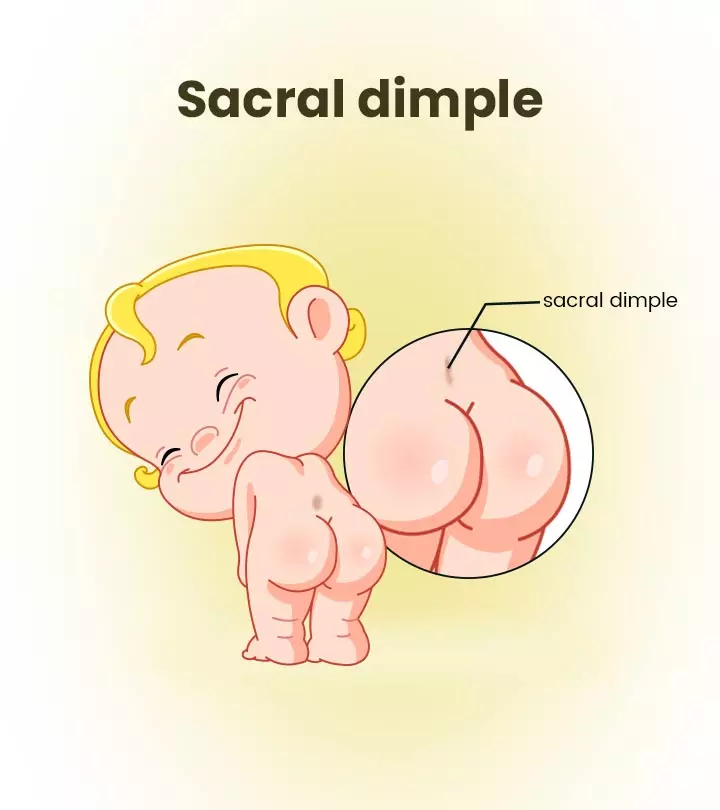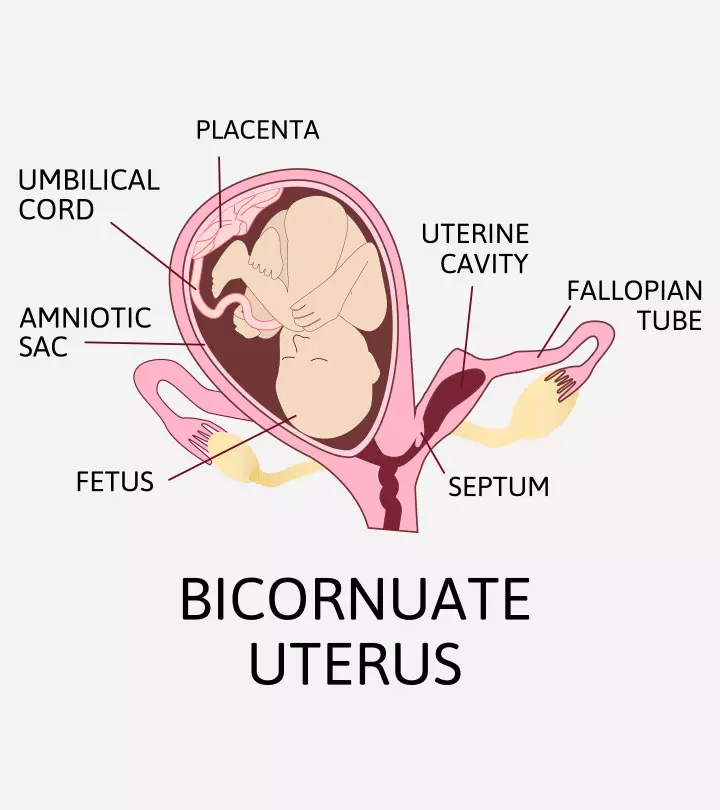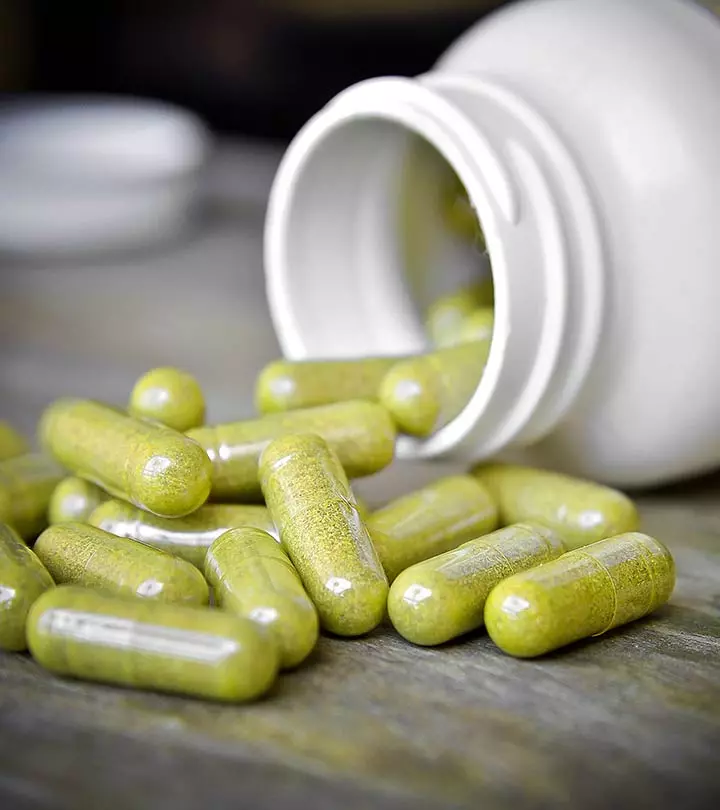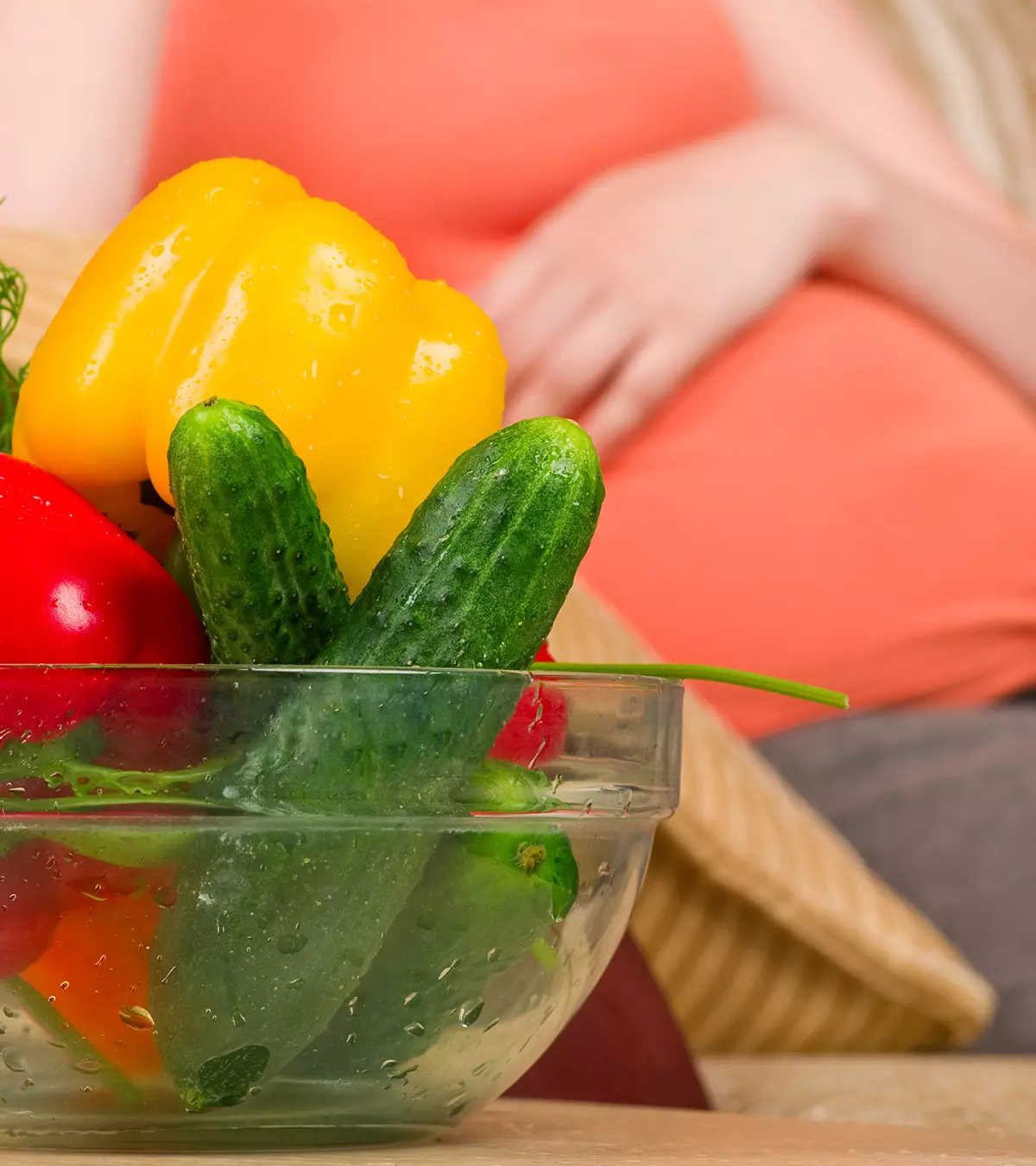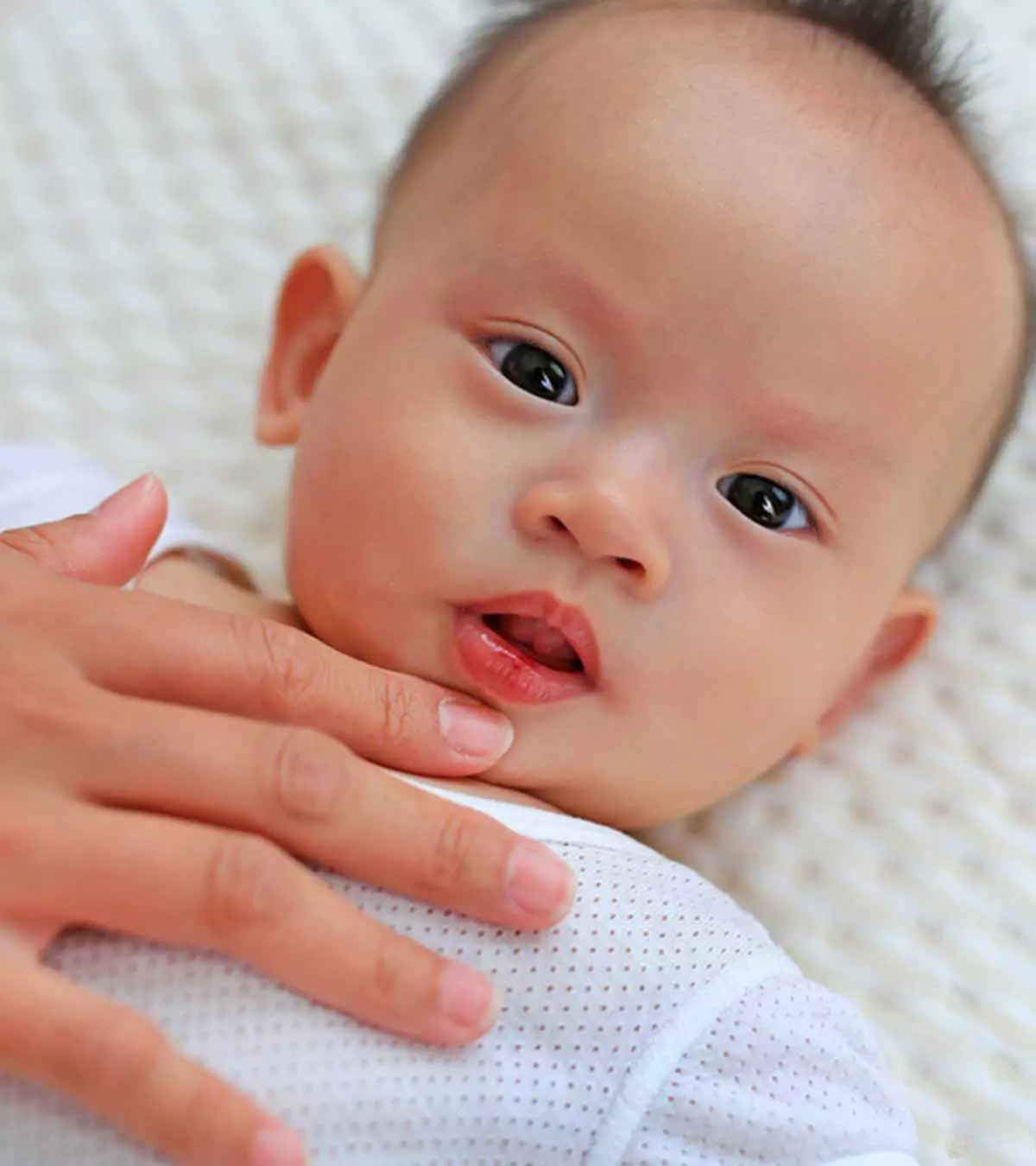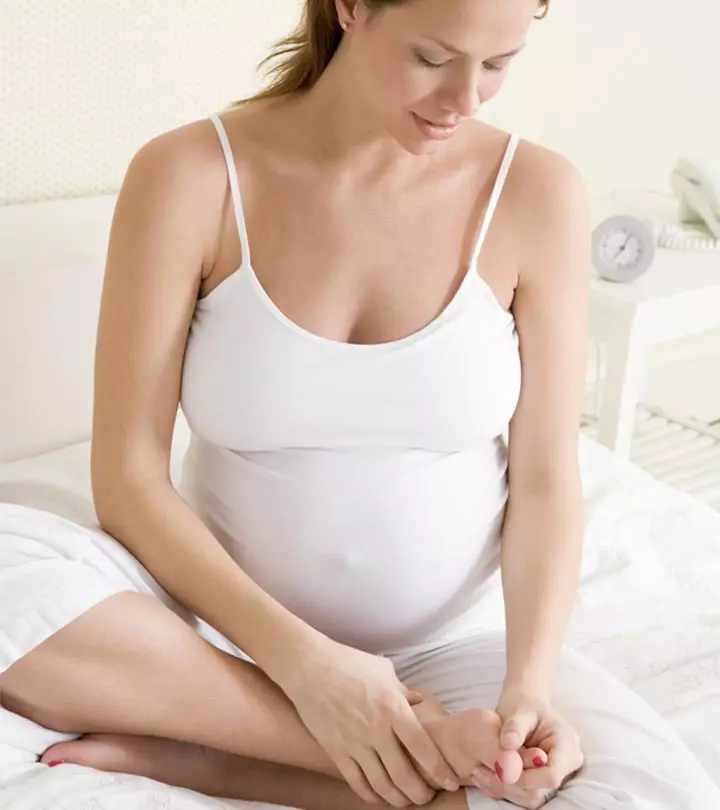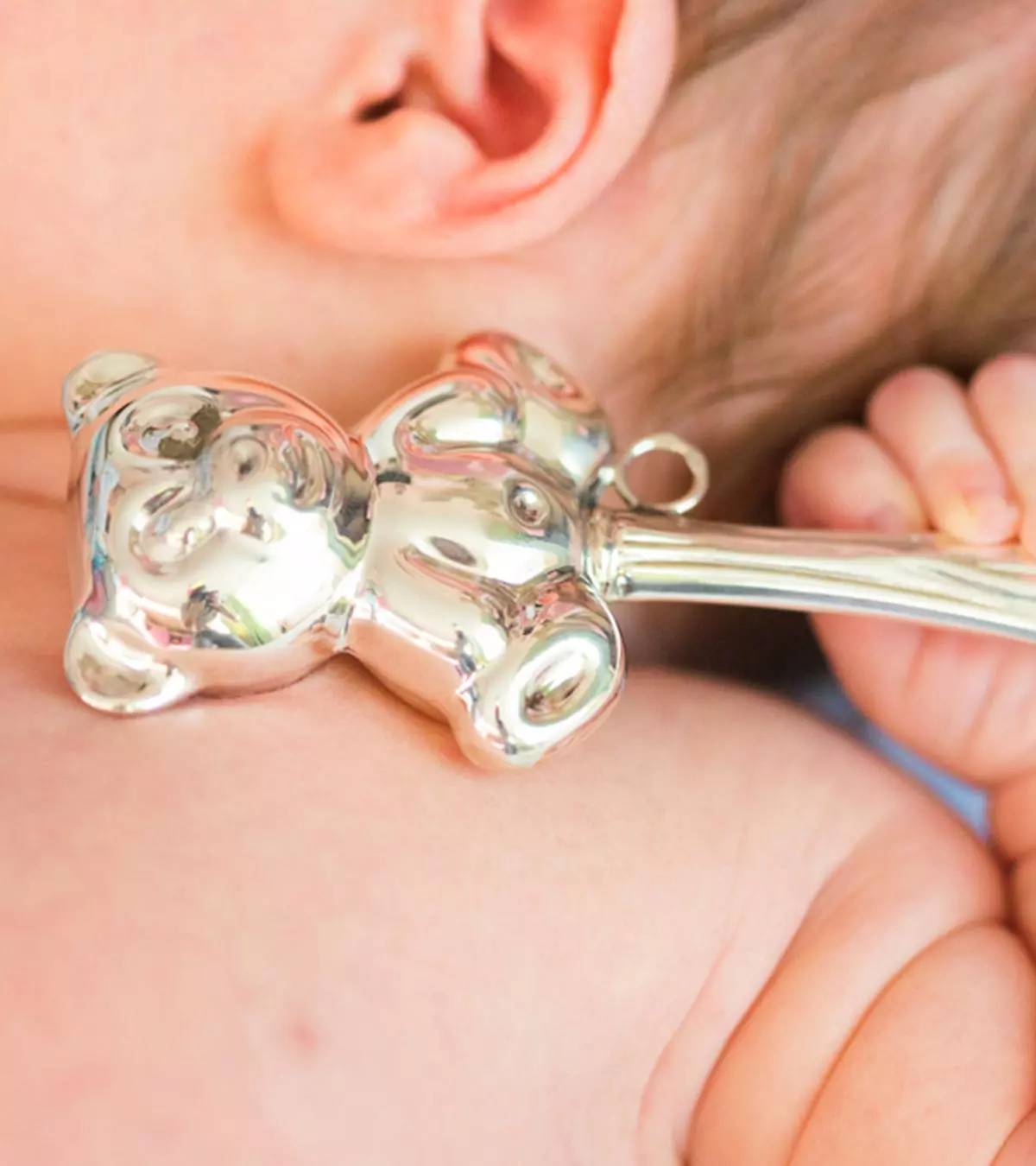
Image: Shutterstock
As you introduce solid foods to your children and encourage them to go ahead with eating with the help of spoons, you may wonder about the safety of silverware for babies.
There can be several other utensil options as well. Some may consider plastic, but its safety becomes a concern since it may contain potentially harmful BPA and phthalates. This brings us to the use of silverware for babies and if they can be a better and safer alternative.
Read on to know about the safety of silverware for babies.
Key Pointers
- Many cultures use silverware when feeding young infants; however, be sure the cutlery is made of pure silver.
- You may give your baby silver cutlery when they reach around 24 months of age.
- Pure silver cutlery is proved to have antibacterial properties, is non-toxic, free of BPA and phthalates, and has a long shelf life.
- Acidic meals kept in silver cutlery may change food’s flavor and tarnish the silver.
Is It Good To Use Silver Cutlery For A Baby?
Parents in many cultures use silver cutlery while feeding young children. You may even have received silver bowls and spoons as gifts during the baby shower or on your baby’s first birthday. When transitioning your baby to solid foods, it could be tempting to use the gorgeous silver-plated baby Christening spoon your granny gave you.
However, while silverware is a good choice for babies, you need to keep certain things in mind before you start using it – one of which is knowing when you can start using it. Also, make sure the items are made of pure silver and not alloys of silver with cadmium or other metals.
 Did you know?
Did you know?When Can You Start Using Silverware For Babies?
When you first start feeding solid foods to your child, it is a good idea to use a silicone or rubber baby fork or spoon.
These infant utensils are safe for use while feeding. At this early stage, the child may bite on the spoon and chew it due to the teething pain. A silver spoon at this initial stage could hurt the insides of the child’s mouth. Choose a customized baby spoon that has been designed factoring in the fact that the cutlery may touch the sides of the baby’s mouth and their lips and gums during the feeding process.
By the time the baby is about six to nine months, they start getting curious about cutlery and try to grab the spoon with which you feed them. By 14 months, babies can learn to dip a spoon into their food and bring it to their mouth. It’s important to serve suitable 14-month-old baby food that they can comfortably pick up and self-feed. Start with a specially designed baby spoon, while you can continue to use silver spoons.
By the age of around 24 months, you may offer silver spoons to the child as they are now more adept at using one on their own with decent motor control. This improved motor control ensures that the spoon smoothly goes in and out without scraping against the sides of the mouth or gums (1).
Ashley, a mother of two beautiful girls, talks about introducing her children to silverware cutlery and says, “For the fork, you’re probably going to need to wait until roughly nine to ten months old. Once they have started developing their pincer grasp, that’s usually a good time to start getting them to use the fork (i).”

Image: IStock
Benefits Of Using Silverware For Babies
The following are a few proven benefits of using silverware while feeding your baby.
- Antimicrobial properties: The antimicrobial properties of silver have been well-documented by researchers, which gives you a valid reason for transitioning to silver cutlery for your little one. Silver is known to kill bacteria, fungi, and certain viruses and has a long history of use in medical, personal care, and domestic applications. Given the findings, you can rest assured that microbes cannot remain on your silver cutlery for long (2) (3).
- Low maintenance: Since silver utensils can be cleaned, sterilized, and dried quickly, they are easy to maintain. You can load silverware into the dishwasher or give it a good wash by hand using a mild cleaning agent and warm water. If you would like to sterilize it, you can also gently lower the silver spoons and baby-feeding bowls in hot water and let them soak for a few minutes.
- Non-toxic: Some metals, such as mercury and lead, are toxic to humans. However, silver is non-toxic and perfectly safe for use in the kitchen. It is not known to have adverse effects on human health. Even if ingested accidentally, silver passes through the body and is expelled naturally, meaning it does not get absorbed into the tissues (4).
- BPA-free: Bisphenol A or BPA is a chemical that goes into many plastic products, including cutlery, containers used to store water and food, and the linings of infant formula and food cans. This chemical hardens plastic (5). BPA can seep into the food or water and affect your child’s brain and prostate gland and lead to behavioral changes in them (6). Using silver baby feeding bowls and silver spoons is an excellent way to avert the risk of BPA from plastics leaching into the baby’s food, especially if you tend to use bowls for storing baby food.

Image: IStock
- Phthalate-free: Phthalates are used in the manufacture of PVC and other plastics. Apart from the antiandrogenic effects, phthalates are also believed to impact children’s psychomotor abilities and cognitive functions (7). Thus, if you are looking for phthalate-free utensils for your child, silver is a great option.
- Long life and resilience: The food-grade baby feeding bowls you find in the market have a limited shelf life, while the glass containers are difficult to manage with an active baby at home, and they also present a risk of injury if they shatter. With silver, both these problems are eliminated. You can use silver utensils for years on end and pass them on to the next generation without any qualms. It is also unbreakable, so a few drops and knocks may scratch or dent it but won’t damage it beyond use. More importantly, there is no risk of silver breaking into shards and injuring the child.
 Quick fact
Quick factTypes Of Silverware Available For Babies
Silver kitchen sets include the following.
- Silver bowl: The advantage of silver bowls is that you can store both hot and cold foods in them without worry. Make sure you have a bowl with a proper-fitting lid so that you can quickly cover the food when the child gets distracted in the middle of a feeding session. A bowl comes in handy while storing baby food items, including soups, semi-solids, and solids, or even finger foods for a baby who is just exploring eating on their own.
- Silver plate: This is an ideal utensil for letting your baby explore eating on their own or get a feel of solid foods. A silver plate could be an add-on to a bowl, or you could use it as a substitute for one if it has enough depth for your child to scoop out food effortlessly.

Image: Shutterstock
- Silver spoon: A well-designed silver spoon is a great alternative to plastic feeding spoons, which usually contain harmful chemicals. Silver spoons can also be used for a long time and are hygienic.
 Quick tip
Quick tip- Silver glassware: Once you have accustomed the child to drinking directly from a cup, giving them a silver cup glassware is ideal. You can leave milk, water, or other liquids in it for long without the risk of any chemicals leaking into the edible item.
Tips On Using Silverware For Babies
Keep these tips in mind when introducing a silver feeding set to your baby.
Glasses
- Choose a lightweight product that is handy enough for the child to clutch securely in their little hands.
- Avoid giving them adult-sized glasses that may be prone to slipping out of their grip owing to their diameter and weight.
- Glasses that come with handles make drinking from them easier for the child.
- Always check and recheck if the edges are smooth and well-rounded. Sharp edges may cut the child’s soft lips when they drink from the cup or glass.
Bowls

Image: Shutterstock
- When feeding solid foods to your little one, give them a small silver bowl they can hold easily.
- An active, curious child is sure to grab things they can lay their hands on. Thus, ensure the silver bowl you are using is easy to hold and not too big to be easily knocked out of your hands.
- When your toddler is old enough to eat directly from the bowl, get one that is easy for them to grab.
- Give your baby a slightly heavier bowl so that it doesn’t tip over when the child dips the spoon to scoop out the food.
Spoons
- Silver spoons are usually heavy, so get one that is designed for children and is light enough for them to handle.
- Avoid ornate silver spoons and bowls because these are tough to clean. Also, food particles may stick within the intricate designs.
- Short-handled silver spoons are good toddler cutlery to easily maneuver without much spillage.
- The edges of the silver spoons meant for the child must be well-rounded. This helps avoid cuts and bruises inside the child’s mouth or on the lips.
Plates
- Use a slightly heavy plate that will not flip over when the child scoops up food from it.
- Ensure it is not excessively heavy because there is a risk of the baby pulling it off the table and hurting their foot.
- Ensure your baby’s plate has no sharp edges.
- Plates with some depth and high-rounded edges are a good choice because they reduce spillage.
How To Clean Silver Vessels?

Image: IStock
You may clean your child-friendly silverware with warm water and a mild dishwashing liquid. Silverware can also go into the dishwasher. However, silverwares is prone to scratches, so avoid putting too many at one go.
Generally, if you keep using your silver bowls, spoons, and glasses, you will hardly find tarnishes in them. However, these tips might help you get your baby’s silverware back to its pristine shine if it loses its sheen. Here is how you should clean tarnished silver cutlery:
- Place a sheet of aluminum foil in a large, flat bowl. The shiny side faces upwards.
- Arrange the tarnished spoons and bowls over the foil in a row.
- Pour in hot water, so all the utensils are submerged.
- Sprinkle a few tablespoons of baking soda.
- Leave it for some time, and you will see the foil absorbing the tarnish and the utensils acquiring a lovely sparkle and shine.
- Take them out and clean them thoroughly with soap and water.
- Rinse them thoroughly with water to get rid of all the baking soda.
- Dry them with a soft cloth to make them ready for use.
Can You Use Silver Utensils For Acidic Foods?
While silver is not toxic and does not affect the taste of most foods, some foods may taste different if you store and serve them in silver utensils. In particular, acidic foods may change in taste if stored in silver utensils. They may also tarnish the silver. Eggs may also taste different when eaten off silver bowls or plates due to the sulfur content that reacts with the silver (8).
Frequently Asked Questions
1. Is sterling silver good for babies?
Sterling silver is an alloy of silver that contains 92.5% by weight of silver and 7.5% weight by an alloy, usually copper. There have been anecdotal reports that pure silver confers antimicrobial properties and prevents illnesses, but whether or not these alloys are safe is unknown.
2. Is a silver bottle good for a baby?
Silver bottles are an environment-friendly, durable, and reusable alternative to plastic and glass containers as they are free from harmful chemicals like BPA and phthalates making them safer than plastics (2) (5). In addition, they may be easy to maintain and clean.
3. Does silver react with milk?
Anecdotally, it was believed that putting a silver coin in milk can inhibit bacterial growth and may help prevent the milk from getting spoilt. However, there is no detailed scientific research done to verify this.
Silverware for babies has been used for generations. However, before introducing silver utensils to children, remember that they are hard and may hurt babies’ mouths. So, do not use silverware early when they are starting solids. Instead, you may introduce silverware as babies become more adept at handling utensils and eating food. These utensils are a good choice because of their antimicrobial properties, low maintenance, and non-toxic nature. Choose specially-made silver baby feeding utensils and enjoy safe and worry-free feeding time.
Infographic: How To Know If Your Silverware Is Pure?
Only pure silverware is recommended for a baby’s use. It is important to ascertain the purity of the silverware to prevent infants from being exposed to toxic metals such as lead. Other metals, such as iron, that are not considered harmful may also be present. The infographic below lists some tests to determine the purity of silverware. Illustration: Momjunction Design Team
Illustration: Benefits Of Silver Utensils For Babies And Tips To Use

Image: Dall·E/MomJunction Design Team
Personal Experience: Source
MomJunction articles include first-hand experiences to provide you with better insights through real-life narratives. Here are the sources of personal accounts referenced in this article.
i. Baby led weaning: Introducing a spoon and fork.https://www.youtube.com/watch?feature=shared&v=Ht4_ltUIsTI
References
1. Using Cutlery; NHS Greater Glasgow and Clyde
2. Wilson Sim et al.; Antimicrobial Silver in Medicinal and Consumer Applications: A Patent Review of the Past Decade (2007–2017); Antibiotics (Basel) (2018).
3. Silver. A powerful weapon against microbes; Coloplast Group
4. The Facts on Silver; Dartmouth Toxic Metals Superfund Research Program
5. BPA and the Controversy about Plastic Food Containers; National Capital Poison Center
6. Nutrition and healthy eating; Mayo Foundation for Medical Education and Research (MFMER)
7. Stephanie M. Engel et al.; Neurotoxicity of Ortho-Phthalates: Recommendations for Critical Policy Reforms to Protect Brain Development in Children; American Journal of Public Health
8. It Turns Out Silver Spoons Make Food Taste Awful; Vice
Community Experiences
Join the conversation and become a part of our nurturing community! Share your stories, experiences, and insights to connect with fellow parents.
Read full bio of Dr. Rana Chanchal
Read full bio of Rohit Garoo
Read full bio of Dr. Ritika Shah
Read full bio of Ghazia Shah











